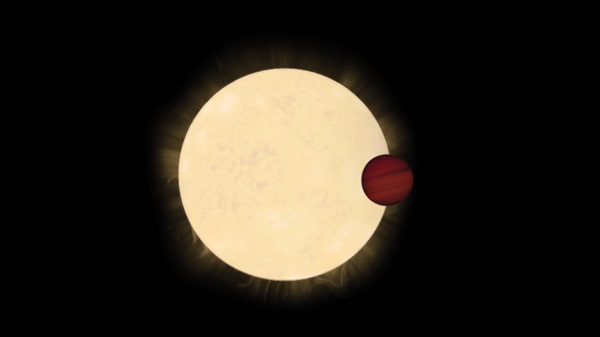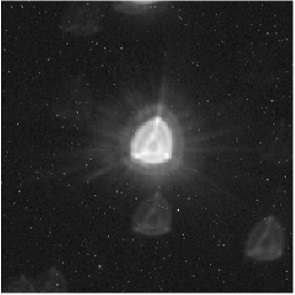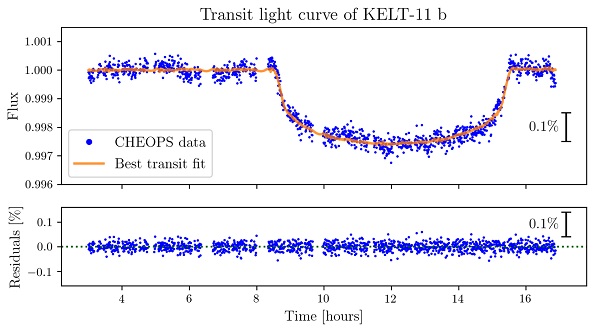CHEOPS observes its first exoplanets and is ready for science
16 April 2020
CHEOPS, ESA's new exoplanet mission, has successfully completed its almost three months of in-orbit commissioning, exceeding expectations for its performance. The satellite, which will commence routine science operations by the end of April, has already obtained promising observations of known exoplanet-hosting stars, with many exciting discoveries to come. |
| Artist's impression of star HD 93396 and its planet. Credit: ESA |
"The in-orbit commissioning phase was an exciting period, and we are pleased we were able to meet all requirements," says Nicola Rando, CHEOPS project manager at ESA. "The satellite platform and instrument performed remarkably, and both the Mission and Science Operation Centres supported operations impeccably."
Launched in December 2019, CHEOPS, or the Characterising Exoplanet Satellite, opened its eye to the Universe at the end of January and shortly after took its first, intentionally blurred images of stars. The deliberate defocusing is at the core of the mission's observing strategy, which improves the measurement precision by spreading the light coming from distant stars over many pixels of its detector.
Precision is key in today's exoplanet research. More than 4000 planets – and counting – are known to be orbiting stars other than the Sun. A key follow-on is to start to characterise these planets, providing constraints on their structure, formation and evolution.
Taking the steps to characterise exoplanets through the precise measurement of their sizes – in particular those of smaller planets – is exactly the mission of CHEOPS. Before being declared ready for the task, however, the small, 1.5 metre sized satellite had to pass a large number of tests.
Outstanding performance
With the first series of in-flight tests, performed between January and February, the mission experts started analysing the response of the satellite, and in particular of the telescope and detector, in the actual space environment. Proceeding into March, CHEOPS focused on well-studied stars.
 |
| CHEOPS image of star HD 88111, which is not known to host any exoplanets. Credit: ESA/Airbus/CHEOPS Mission Consortium |
"To measure how well CHEOPS performs we first needed to observe stars whose properties are well known, stars that are well-behaved – hand-picked to be very stable, with no signs of activity" says Kate Isaak, CHEOPS project scientist at ESA.
This approach enabled the teams at ESA, the mission consortium and Airbus Spain – the prime contractor – to verify that the satellite is as precise and stable as needed to meet its ambitious goals.
"The pointing is extremely stable: this means that while the telescope observes a star for hours while the spacecraft moves along its orbit, the image of the star remains always within the same group of pixels in the detector," explains Carlos Corral van Damme, ESA's System Principal Engineer for CHEOPS.
"Such a great stability is a combination of the excellent performance of the equipment and of the bespoke pointing algorithms, and will be especially important to fulfill the scientific objectives of the mission. The thermal stability of the telescope and the detector has also proven to be even better than required," adds Carlos.
The commissioning period demonstrated that CHEOPS achieves the required photometric precision and, importantly, it also showed that the satellite can be commanded by the ground segment team as needed to perform its science observations.
"We were thrilled when we realized that all the systems worked as expected or even better than expected," says CHEOPS Instrument Scientist Andrea Fortier, who led the commissioning team of the consortium for the University of Bern, Switzerland.
Time for exoplanets
During the final two weeks of in-orbit commissioning, CHEOPS observed two exoplanet-hosting stars as the planets 'transited' in front of their host star and blocked a fraction of starlight. Observing transits of known exoplanets is what the mission was built for – to measure planet sizes with unprecedented precision and accuracy and to determine their densities by combining these with independent measurements of their masses.
One of the targets was HD 93396, a subgiant yellow star located 320 light-years away, slightly cooler and three times larger than our Sun. The focus of the observations was KELT-11b, a puffy gaseous planet about 30% larger in size than Jupiter, in an orbit that is much closer to the star than Mercury is to the Sun.
 |
| Transit light curve of exoplanet KELT-11b. Credit: CHEOPS Mission Consortium |
The light curve of this star shows a clear dip caused by the eight hour-long transit of KELT-11b. From these data, the scientists have determined very precisely the diameter of the planet: 181 600 km – with an uncertainty just under 4300 km.
The measurements made by CHEOPS are five times more accurate than those from Earth, explains Willy Benz, Principal Investigator of the CHEOPS mission consortium, and professor of astrophysics at the University of Bern. "That gives us a foretaste for what we can achieve with CHEOPS over the months and years to come," he says.
A formal review of the satellite performance and ground segment operations was held on 25 March, and CHEOPS passed it with flying colours. With this, ESA handed over responsibility for operating the mission to the consortium led by Willy Benz.
Fortunately, the commissioning activities were not affected much by the ensuing emergency caused by the coronavirus pandemic, which resulted in social distancing measures and restrictions to movement across Europe to prevent the spread of the virus.
"The ground segment has been working very smoothly from early on, which enabled us to fully automate most of the operations for commanding the satellite and downlinking the data already in the first few weeks after launch," explains Carlos. "By the time the crisis emerged in March, with the new rules and regulations that came with it, the automated systems meant that the impact on the mission was minimal."
CHEOPS is currently transitioning towards routine science operations, which are expected to begin before the end of April. Scientists have started observing some of the 'early science targets' – a selection of stars and planetary systems chosen to showcase examples of what the mission can achieve: these include a 'hot super-Earth' planet known as 55 Cancri e, which is covered in a lava ocean, as well as the 'warm Neptune' GJ 436b, which is losing its atmosphere due to the glare from its host star. Another star on the list of upcoming CHEOPS observations is a white dwarf, the first target from ESA's Guest Observers Programme, which provides scientists from beyond the mission consortium with the opportunity to use the mission and capitalize on its observational capabilities.
More about CHEOPS
CHEOPS is an ESA mission developed in partnership with Switzerland, with a dedicated consortium led by the University of Bern, and with important contributions from Austria, Belgium, France, Germany, Hungary, Italy, Portugal, Spain, Sweden and the UK.
ESA is the CHEOPS mission architect, responsible for procurement and testing of the satellite, launch, the launch and early operations phase, in-orbit commissioning, as well as the Guest Observers' Programme. The consortium of 11 ESA Member States led by Switzerland provided essential elements of the mission. The prime contractor for the design and construction of the spacecraft is Airbus Defence and Space in Madrid, Spain. The CHEOPS mission consortium runs the Mission Operations Centre located at INTA, in Torrejón de Ardoz near Madrid, Spain, and the Science Operations Centre, located at the University of Geneva, Switzerland.
For further information, please contact:
Nicola Rando
ESA CHEOPS project manager
Email: nicola.rando![]() esa.int
esa.int
Kate Isaak
ESA CHEOPS project scientist
Email: kate.isaak![]() esa.int
esa.int
Carlos Corral van Damme
ESA CHEOPS System Principal Engineer
Email: carlos.corral.van.damme![]() esa.int
esa.int
ESA Media Relations
Email: media![]() esa.int
esa.int



